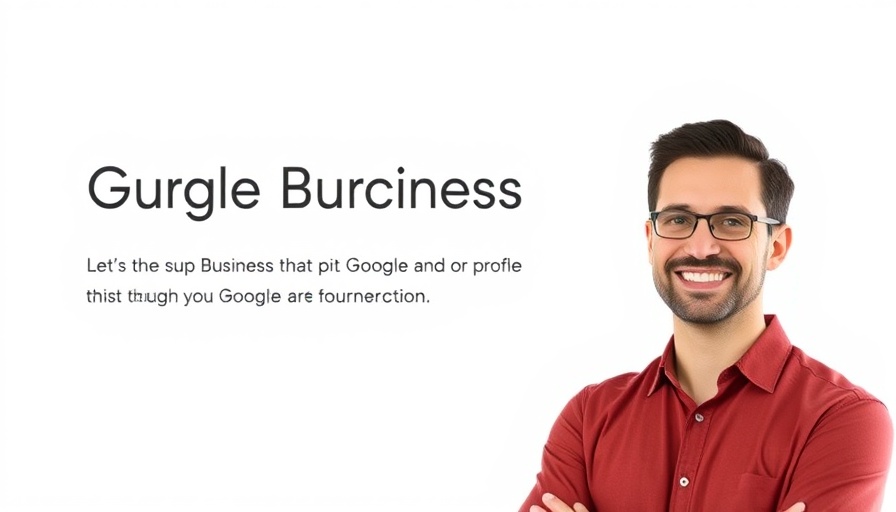
Unlock Your Business Potential: Setting Up a Google Business Profile
As we move into 2025, having a Google Business Profile is crucial for professionals, business owners, and marketers alike. This free platform helps your business pop up in Google Search results and Maps, significantly improving discoverability. In this article, we explore step-by-step how to create a Google Business Profile that not only enhances your online presence but also boosts your Google ranking.
In 'Google Business Profile Set Up: 2025 Step-By-Step Tutorial,' we explore how to effectively establish a Google Business Profile and its significance in optimizing your online presence.
Why You Need a Google Business Profile
A Google Business Profile is invaluable for local SEO. It connects your business with potential customers who are actively searching for services like yours. From a dentist's office to a plumbing service, establishing your presence on Google can translate into increased foot traffic and leads. The best part? It’s free! By claiming your profile and setting it up correctly, you're taking a significant step toward being found online.
Basic Requirements For Setting Up Your Profile
Before diving into the setup process, ensure your business meets a few essential criteria. Your business must: 1) serve customers in person, either at a physical location or through home visits; 2) possess a valid address—virtual offices or PO boxes won’t qualify; and 3) maintain a phone number actively managed during business hours. Once you've verified these requirements, you're ready to create your account.
Creating Your Google Business Account
The first step is to set up a Google Account specifically for your business. While you can use a personal Gmail address, having a separate account helps maintain organization. Visit accounts.google.com to create a business account. Choose an account name that reflects your business. For example, "Allstar Pest Control Batan" not only sounds memorable but also aids in marketing strategy by featuring relevant keywords for SEO.
Claiming Your Google Business Profile
Once your account is ready, go to google.com/business and sign in. You will see options to manage or create your business profile. Enter your business name; Google may have already created a profile for you, which minimizes setup time. If not, select 'Create a business with this name' and continue.
Choosing the Right Business Category: A Key SEO Tip
Your business category affects visibility on Google. Choosing the right category ensures your business is displayed when potential customers search for relevant services. For example, if you run a restaurant, your category might be "Italian Restaurant" or "Fine Dining." Research competitors on Google Maps to see prevalent categories for similar businesses. Use insights from top listings to determine the most effective category for your profile.
The Importance of Accurate Service Areas
If you operate a service-based business, include all the areas you serve. This not only helps with Google ranking but also ensures customers can find you easily. Limit your service area to places within a reasonable distance—like a two-hour drive from your primary location—to comply with Google guidelines.
Verification: Why It Matters
Verifying your Google Business Profile is fundamental. It authenticates your business and ensures that prospects can trust the information provided. Google offers several verification methods including phone, postcard, or video verification. Each method serves to affirm that your business details are accurate and that you are indeed the owner. Video verification, for instance, requires a brief recording demonstrating your business location and services.
Enhancing Your Profile Post-Verification
After your profile is verified, don’t stop there. Add vital information such as business hours, a compelling business description, and a list of the services you offer. Keep in mind that accuracy matters; Google favors consistency across different platforms. Establish a clear schedule and make it known that you value customer convenience by listing actual operating hours.
Using Photos to Increase Engagement
Profiles complete with images see significantly higher interaction rates on Google. According to Google, businesses with photos receive 42% more requests for directions and 35% more website clicks. Include images of your team, products, or services, ensuring authenticity by avoiding stock photos. Fresh, engaging visuals can captivate your audience and convey your brand's story effectively.
Review and Respond: Building Reputation
Once your profile is live, encourage satisfied customers to leave reviews. Responding to reviews—both positive and negative—demonstrates a committed customer service approach, which can enhance your business reputation and foster a sense of trust with potential customers.
Conclusion: Take Action for Enhanced Visibility
With a well-optimized Google Business Profile, you're equipped to increase your visibility in a competitive digital landscape. Don’t leave this opportunity on the table; start setting up your profile today to reap the benefits. For further insights into e-commerce SEO and digital marketing, explore more articles tailored for your business growth.
 Add Row
Add Row  Add
Add 




Write A Comment